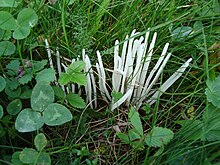Clavaria fragilis
| Clavaria fragilis | |
|---|---|

| |
| Scientific classification | |
| Domain: | Eukaryota |
| Kingdom: | Fungi |
| Division: | Basidiomycota |
| Class: | Agaricomycetes |
| Order: | Agaricales |
| Family: | Clavariaceae |
| Genus: | Clavaria |
| Species: | C. fragilis
|
| Binomial name | |
| Clavaria fragilis Holmsk. (1790)
| |
| Synonyms[1] | |
|
Species synonymy
| |
| Clavaria fragilis saprotrophic | |
|---|---|
| Edibility is edible | |
Clavaria fragilis, commonly known as fairy fingers, white worm coral, or white spindles, is a
History and taxonomy
Clavaria fragilis was
In North America, the fungus has colloquially been called "fairy fingers"[4] or "white worm coral".[5] In the UK its recommended English name is "white spindles".[6] British naturalist Samuel Frederick Gray called it the "worm club-stool" in his 1821 A Natural Arrangement of British Plants.[7]
Description

The fruit bodies of C. fragilis are irregularly tubular, smooth to furrowed, sometimes compressed, very fragile, white, up to 15 cm (6 in) tall by 5 mm (0.2 in) thick, and typically grow in dense clusters.
Edibility
Clavaria fragilis is nonpoisonous[13] and reportedly edible, but the fruit bodies are insubstantial and fragile.[14] One field guide says "its flesh is tasteless and so delicate that it seems to dissolve in one's mouth."[9] Its odor has been compared to iodine.[10]
Distribution and habitat
The species occurs throughout the Northern Hemisphere, in Europe, North America, and Asia. In North America, it is more common east of the Rocky Mountains.[10] It has also been recorded from Australia and South Africa.[8] In 2006, it was reported from the Arctic zone of the Ural Mountains, in Russia.[15]
The fungus grows in woodland and in grassland on moist soil, and is presumed to be
Similar species

Similar fungi with simple, white fruit bodies include
Other similar species include Alloclavaria purpurea, Clavulinopsis fusiformis, Clavulinopsis laeticolor, and Macrotyphula juncea.[20]
Conservation status
In North America, Clavaria fragilis has been called "by far our most common Clavaria".
References
- ^ a b "Clavaria fragilis Holmsk. 1790". MycoBank. International Mycological Association. Retrieved 2010-10-11.
- ^ Holmskjold T. (1790). Beata Ruris Otia Fungis Danicis Impensa [Happy Resting Periods in the Country Studying Danish Fungi] (in Latin). Vol. 1. p. 7.
- ^ Fries EM (1821). Systema Mycologicum. Vol. 1. Greifswald, Germany: Mauritius. p. 484. Retrieved 2010-10-10.
- ^ ISBN 0-89815-009-4. Retrieved 2010-10-11.
- ISBN 0-394-51992-2.
- ^ "Recommended English Names for Fungi in the UK" (PDF). British Mycological Society. Archived from the original (PDF) on 2011-07-16. Retrieved 2010-10-11.
- ^ Gray SF (1821). A Natural Arrangement of British Plants. Vol. 1. London: Baldwin, Cradock, and Joy. p. 657.
- ^ a b c d Corner EJH (1950). A Monograph of Clavaria and Allied Genera. Cambridge, UK: Cambridge University Press. pp. 251–54.
- ^ ISBN 0-520-03656-5.
- ^ ISBN 0-395-91090-0.
- ISBN 0-02-063690-3.
- ISBN 0-412-36970-2.
- ISBN 978-0-7627-3109-1.
- ISBN 0-295-96480-4.
- ISSN 0026-3648.
- ISBN 978-1-58729-627-7.
- ISBN 978-0-88192-935-5.
- ^ Kuo M. "Clavaria vermicularis". MushroomExpert.Com. Retrieved 2010-04-12.
- ISBN 0-8131-9039-8. Retrieved 2010-10-11.
- OCLC 797915861.
- ^ McHugh R, Mitchel D, Wright M, Anderson R (2001). "The fungi of Irish grasslands and their value for nature conservation". Biology and Environment: Proceedings of the Royal Irish Academy. 101B: 225–42.
- ^ Winnall R. (2004). "Waxcap Grasslands". Retrieved 2010-10-11.
- .
- ^ "Rode Lijst". 2008. Retrieved 2010-11-28.
- ^ "Slovenian Red List". 2010. Archived from the original on 2010-08-22. Retrieved 2011-01-12.
 Media related to Clavaria fragilis at Wikimedia Commons
Media related to Clavaria fragilis at Wikimedia Commons
